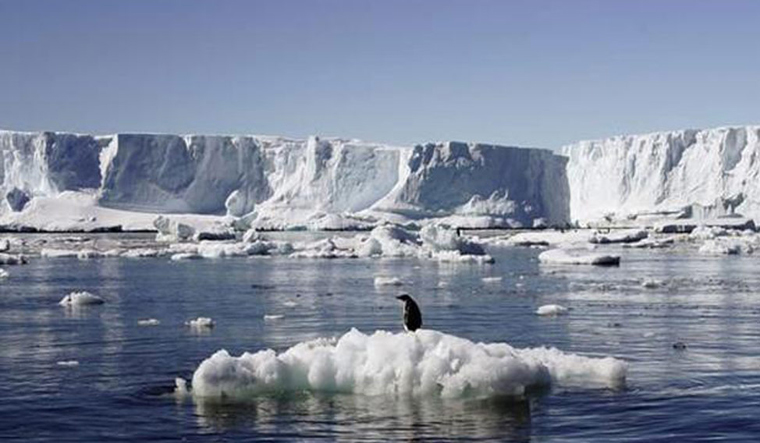‘Devastating’ Melting Of Greenland & Antarctic Ice-Sheets Found
Apr 21, 2023 | Pratirodh Bureau
Greenland's average annual melt from 2017 to 2020 was 20 per cent more a year than at the beginning of the decade and more than seven times higher than its annual shrinkage in the early 1990s (Representational Image)
Source: PTI
The Greenland and Antarctic ice sheets are now losing more than three times as much ice a year as they were 30 years ago, according to a new comprehensive international study.
Using 50 different satellite estimates, researchers found that Greenland’s melt has gone into hyperdrive in the last few years.
Greenland’s average annual melt from 2017 to 2020 was 20 per cent more a year than at the beginning of the decade and more than seven times higher than its annual shrinkage in the early 1990s.
The new figures are pretty disastrous really, said study co-author Ruth Mottram, a climate scientist at the Danish Meteorological Institute.
“We’re losing more and more ice from Greenland.”
Study lead author Ines Otosaka, a glaciologist at the University of Leeds in the United Kingdom, said speeded-up ice sheet loss is clearly caused by human-caused climate change.
From 1992 to 1996, the two ice sheets which hold 99 per cent of the world’s freshwater ice were shrinking by 116 billion tons (105 billion metric tons) a year, two-thirds of it from Antarctica.
But from 2017 to 2020, the newest data available, the combined melt soared to 410 billion tons (372 billion metric tons) a year, more than two-thirds of it from Greenland, said the study in Thursday’s journal Earth System Science Data.
“This is a devastating trajectory,” said US National Snow and Ice Center Deputy Lead Scientist Twila Moon, who wasn’t part of the study.
These rates of ice loss are unprecedented during modern civilization. Since 1992, Earth has lost 8.3 trillion tons (7.6 trillion metric tons) of ice from the two ice sheets, the study found.
That’s enough to flood the entire United States with 33.6 inches (almost 0.9 metres) of water or submerge France in 49 feet (nearly 15 metres).
But because the world’s oceans are so huge, the melt just from the ice sheets since 1992 still only adds up to a little less than inch (21 millimetres) of sea level rise, on average.
Globally sea level rise is accelerating and melt from ice sheets has gone from contributing 5 per cent of the sea level rise to now accounting for more than one-quarter of it, the study said.
The rest of the sea rise comes from warmer water expanding and melt from glaciers.
A team of more than 65 scientists regularly calculates ice sheet loss in research funded by NASA and the European Space Agency with Thursday’s study adding three more years of data.
They use 17 different satellite missions and examine ice sheet melt in three distinct techniques, Otosaka said, and all the satellites, radar, on the ground observations and computer simulations basically say the same thing — ice sheet melting is accelerating.
Greenland from 2017 to 2020 averaged about 283 billion tons (257 billion metric tons) of melting a year, compared to just 235 billion tons (213 billion metric tons) annually from 2012 to 2016.
The latest figures also showed what looks like a slowing of melting in parts of Antarctica, which has much more ice than Greenland.
“That’s mostly due to smaller and fleeting weather changes and the overall longer-term trend still shows an acceleration of melting in Antarctica,” Mottram said.
Antarctica from 2017 to 2020 is still losing about 127 billion tons (115 billion metric tons) of ice a year, down 23per cent from earlier in the decade, but overall up 64 per cent from the early 1990s.
“While mass loss from Greenland is outpacing that from Antarctica, there are troublesome wild cards in the south, notably behaviour of the Thwaites glacier, which is nicknamed the Doomsday Glacier,” said Mark Serreze, director of the US snow and ice center, who wasn’t part of the study.
Study authors used changes in gravity and in ice height and measured how much snow fell, how much snow melted, how much ice was lost in icebergs calving and eaten away from underneath by warmer water etching through the ice.
This matters because rising sea levels will displace and/or financially impact hundreds of millions of people, if not billions, and will likely cost trillions of dollars, said University of Colorado ice researcher and former NASA chief scientist Waleed Abdalati, who wasn’t part of the study.
The study is not so much surprising as it is disturbing, Abdalati said in an email.
A few decades ago, it was assumed that these vast reservoirs of ice changed slowly, but through the use of satellite observations, field observations and modeling techniques, we have come to learn that ice responds rapidly to our changing climate.
